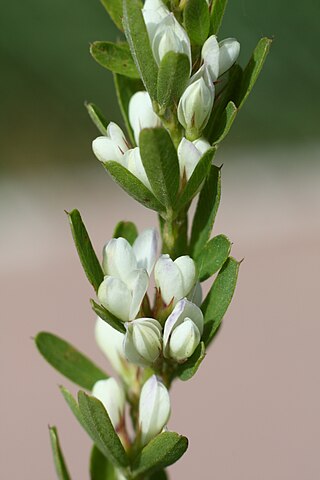
Legumes are plants in the family Fabaceae, or the fruit or seeds of such plants. When used as a dry grain for human consumption, the seeds are also called pulses. Legumes are grown agriculturally, primarily for human consumption; for livestock forage and silage; and as soil-enhancing green manure. Well-known legumes include beans, chickpeas, peanuts, lentils, lupins, mesquite, carob, tamarind, alfalfa, and clover. Legumes produce a botanically unique type of fruit – a simple dry fruit that develops from a simple carpel and usually dehisces on two sides.
Locoweed is a common name in North America for any plant that produces swainsonine, an alkaloid harmful to livestock. Worldwide, swainsonine is produced by a small number of species, most of them in three genera of the flowering plant family Fabaceae: Oxytropis and Astragalus in North America, and Swainsona in Australia. The term locoweed usually refers only to the North American species of Oxytropis and Astragalus, but this article includes the other species as well. Some references may incorrectly list Datura as locoweed.

Astragalus is a large genus of over 3,000 species of herbs and small shrubs, belonging to the legume family Fabaceae and the subfamily Faboideae. It is the largest genus of plants in terms of described species. The genus is native to temperate regions of the Northern Hemisphere. Common names include milkvetch, locoweed and goat's-thorn. Some pale-flowered vetches are similar in appearance, but they are more vine-like than Astragalus.

Alpha-mannosidosis is a lysosomal storage disorder, first described by Swedish physician Okerman in 1967. In humans it is known to be caused by an autosomal recessive genetic mutation in the gene MAN2B1, located on chromosome 19, affecting the production of the enzyme alpha-D-mannosidase, resulting in its deficiency. Consequently, if both parents are carriers, there will be a 25% chance with each pregnancy that the defective gene from both parents will be inherited, and the child will develop the disease. There is a two in three chance that unaffected siblings will be carriers. In livestock alpha-mannosidosis is caused by chronic poisoning with swainsonine from locoweed.

Oxytropis campestris, the field locoweed, is a plant native to Northern Europe, the mountains of Central & Southern Europe, the Northwestern United States and all of Canada, sometimes grown as an ornamental plant.

Swainsonine is an indolizidine alkaloid. It is a potent inhibitor of Golgi alpha-mannosidase II, an immunomodulator, and a potential chemotherapy drug. As a toxin in locoweed it also is a significant cause of economic losses in livestock industries, particularly in North America. It was first isolated from Swainsona canescens.

Oxytropis is a genus of plants in the legume family. It includes over 600 species native to subarctic to temperate regions of North America and Eurasia. It is one of three genera of plants known as locoweeds, and are notorious for being toxic to grazing animals. The other locoweed genus is the closely related Astragalus. Most oxtropis species are native to Eurasia and North America, but several species are native to the Arctic. These are hairy perennial plants which produce raceme inflorescences of pink, purple, white, or yellow flowers which are generally pea-like but have distinctive sharply beaked keels. The stems are leafless, the leaves being all basal. The plant produces legume pods containing the seeds.

Swainsona greyana, commonly known as the Darling pea or hairy-Darling pea, is a species of flowering plant in the family Fabaceae and is endemic to south-eastern continental Australia. It is an erect perennial subshrub with imparipinnate leaves with 17 to 21 egg-shaped leaflets, and racemes of 12 to 20 or more white, pink or purple flowers.

Oxytropis lambertii commonly known as purple locoweed, Colorado locoweed, Lambert's crazy weed, or Lambert’s Locoweed is a species of flowering plant in the legume family.

Slaframine is an bicyclic alkaloid mycotoxin that causes salivation (slobbers) in most animals. It is usually produced by the fungus Rhizoctonia leguminicola which is a common fungal pathogen of red clover (Trifolium pratense) that causes black patch disease in the plant. Slaframine has the molecular formula C10H18N2O2. Wet and humid weather are the favorable environmental condition for the growth of the fungus and production of slaframine. Legume hays contaminated with slaframine cause slobber syndrome and various animals are sensitive to its effects.

Lespedeza cuneata is a species of flowering plant in the legume family known by the common names Chinese bushclover and sericea lespedeza, or just sericea. It is native to Asia and is present elsewhere as an introduced species and sometimes an invasive plant. Australian populations of Lespedeza juncea have sometimes been considered to belong to this species but are now considered to be distinct.

Lupinus sericeus is a species of flowering plant in the legume family known by the common name silky lupine or Pursh's silky lupine. It is native to western North America from British Columbia to Arizona and east to Alberta and Colorado.

Nolina microcarpa is a species of flowering plant in the asparagus family known by the common names sacahuista and palmilla. Like other species of Nolina, it may be called beargrass. It is native to northern Mexico and the southwestern United States in Arizona and New Mexico. It does occur in the southwestern corner of Utah, where it has a limited distribution on Navajo Sandstone, but reports of it occurring in Texas may be in error.

Oxytropis podocarpa is a species of flowering plant in the legume family known by the common names stalkpod locoweed, stalked-pod crazyweed, and Gray's point-vetch. It is native to North America, where it occurs in the northern latitudes, from Yukon and British Columbia across the low arctic to northern Quebec and Labrador. In the Rocky Mountains it occurs at the higher elevations as far south as Colorado.
Physaria fremontii is a species of flowering plant in the family Brassicaceae known by the common name Fremont's bladderpod. It is endemic to Wyoming in the United States, where it occurs only in and around the Wind River Range in Fremont County.

Delphinium barbeyi is a species of flowering plant in the buttercup family known by the common names subalpine larkspur, tall larkspur, and Barbey's larkspur. It is native to the interior western United States, where it occurs in the states of Arizona, Colorado, New Mexico, Utah, and Wyoming.

Oxytropis prenja G. Beck in Reichenb. & Reichenb. Fil. is a species of flowering plant in the legume family, Fabaceae.

Zygacine is a steroidal alkaloid of the genera Toxicoscordion, Zigadenus, Stenanthium and Anticlea of the family Melanthiaceae. These plants are commonly known and generally referred to as death camas. Death camas is prevalent throughout North America and is frequently the source of poisoning for outdoor enthusiasts and livestock due to its resemblance to other edible plants such as the wild onion. Despite this resemblance, the death camas plant lacks the distinct onion odor and is bitter to taste.

Astragalus crassicarpus, known as ground plum or buffalo plum, is a perennial species of flowering plant in the legume family, Fabaceae, native to North America. It was described in 1813. The fruit is edible and was used by Native Americans as food and horse medicine. It is a host of afranius duskywing larvae. It is also known as groundplum milkvetch and pomme de prairie.

Oxytropis splendens, commonly known as showy locoweed, is a flowering perennial in the legume family endemic to the east slope of the Rocky Mountains. Growing in Canada, Alaska, several Great Plains states, and parts of the Mountain West, O. splendens grows well in harsh alpine ecosystems, allowing it to quickly colonize gravel and coal spoils.



















